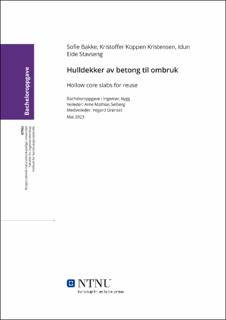| dc.contributor.advisor | Grønstad, Vegard | |
| dc.contributor.advisor | Selberg, Arne Mathias | |
| dc.contributor.author | Bakke, Sofie | |
| dc.contributor.author | Kristensen, Kristoffer Koppen | |
| dc.contributor.author | Stavseng, Idun Eide | |
| dc.date.accessioned | 2023-07-15T17:19:31Z | |
| dc.date.available | 2023-07-15T17:19:31Z | |
| dc.date.issued | 2023 | |
| dc.identifier | no.ntnu:inspera:146719958:51834977 | |
| dc.identifier.uri | https://hdl.handle.net/11250/3079353 | |
| dc.description.abstract | Bygg- og anleggsbransjen bidrar med 15 % av klimagassutslippene og 25 % av avfallsmengden i Norge. Det er ønskelig å undersøke hvordan disse mengdene kan reduseres, og flere rapporter viser at ombruk av bygningsmaterialer kan være en viktig del av strategien for å oppnå dette. Oppgaven har til formål å avdekke drivere og barrierer for ombruk i dag, og basert på disse, utforme forslag til tiltak som kan gjøre ombruk av hulldekker mer attraktivt for aktører i byggebransjen.
Denne problemstillingen besvares ved å benytte kvalitative og kvantitative forskningsmetoder. For å få en bedre forståelse av elementenes konstruksjonstekniske egenskaper, utføres det først en dimensjonering av hulldekker i et industribygg. Videre gjennomføres det en markedsanalyse som tar for seg artikler, rapporter og innspill fra relevante aktører i bransjen. Deretter presenteres det en kostnads- og livsløpsanalyse, som begge tar utgangspunkt i en casestudie basert på oppgavens tema. Resultatene fra analysen blir så drøftet, før det konkluderes med flere mulige løsninger på problemstillingen. Avslutningsvis reflekteres det over valg av problemstilling, prosjektets arbeidsprosess og besvarelsens validitet.
Prosjektarbeidet resulterer i fire spesifikke tiltak som er utformet på bakgrunn av momentene som drøftes i diskusjonsdelen. Det første tiltaket innebærer utvikling og etablering av digitale materialbanker, noe som vil gjøre informasjon om brukte hulldekker mer tilgjengelig. Det andre tiltaket handler om å benytte politiske insentiver, som har til hensikt å sikre at aktører i bransjen tør å satse på ombruksløsninger i tiden fremover. Det tredje tiltaket er å etablere flere geografisk spredte lokasjoner for mellomlagring av ombrukselementer. Det fjerde og siste tiltaket går ut på å utvikle reversible sammenføyninger av hulldekke-elementer, slik at de i større grad blir tilrettelagt for senere demontering. Ettersom prosjekter har stor variasjon i utførelse og omfang, er det viktig å påpeke at det er krevende å utforme tiltak som involverer hele bransjen.
Basert på denne besvarelsen, konkluderes det med at de fire tiltakene vil øke attraktiviteten til ombruk av hulldekker, som alternativ til nyproduksjon i byggebransjen. | |
| dc.description.abstract | The Norwegian construction industry accounts for 15 % of the country's greenhouse gas emissions and 25 % of the total waste generated. These contributions should be reduced, and several reports indicate that reuse of building materials can be a crucial component of the strategy to achieve this. The objective of this thesis is to propose measures that can increase the appeal of reuse of hollow core slabs for entities in the construction industry. The research question is being addressed through the utilization of qualitative and quantitative research methods. To gain a better understanding of the structural properties of hollow core slabs, it is initially performed a design process for them. Subsequently, a market analysis is conducted based on articles, reports, and input from contributors in the industry. Furthermore, cost and life cycle analyses are performed, in which both are based on a case study that addresses the topic of this thesis. The results of the analyses are deliberated upon before reaching a potential solution to the research question. Lastly, the group reflects upon the process of choosing a research question, the progress of the study and the validity of the answers presented.
The study results in four specific measures, which are proposed based on the aspects discussed in this thesis. The first measure entails the development and establishment of digital material banks, which would enhance the accessibility of information about used hollow core slabs. The next measure introduces political incentives with the intention of encouraging industry entities to invest in reuse solutions in the future. The third measure involves establishing geographically distributed locations for intermediate storage of reusable elements. The fourth measure focuses on developing reversible connections for hollow core slabs, enabling greater facilitation of the disassembly of hollow core slabs. It is important to emphasize that designing measures involving the entire industry is highly challenging, given the significant variation in design, execution, and scope of projects.
Based on the results of this thesis, it is concluded that the four presented measures will increase the appeal of reuse of hollow core slabs as an alternative to new production in the construction industry. | |
| dc.language | nob | |
| dc.publisher | NTNU | |
| dc.title | Hulldekker av betong til ombruk | |
| dc.type | Bachelor thesis | |
